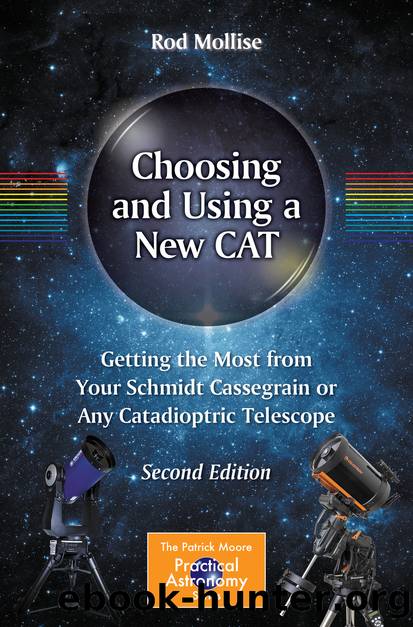Choosing and Using a New CAT by Rod Mollise

Author:Rod Mollise
Language: eng
Format: epub
ISBN: 9783030397777
Publisher: Springer International Publishing
Observers who have not used a binoviewer sometimes question whether this is a practical arrangement. Does not running the light through prisms and splitting it into two dim images mean that little can be seen at the eyepiece? Images are dimmer in binoviewers than in a single-eyepiece set up, but in the best models the loss is small. This light reduction does not do any harm in viewing the Solar System, and its effect on deep sky objects is surprisingly small in good binoviewers.
The plain truth is you can see more detail more easily in any object using a binoviewer than you can with a single eyepiece. The object may be dimmer, but you still get a better view of it. A good example is the faint nebula just north of M42 in Orion, the Running Man, NGC 1973.
All this doesn’t mean that a binoviewer is for everybody. One stumbling block for many people is the fact that two “copies” of every eyepiece are needed for the binoviewer. For best results, these must not only be the same focal length, brand, and design, but they should also have been manufactured at close to the same time. Eyepiece makers incorporate small changes in eyepieces from time to time, which can cause problems for binoviewers, mainly involving merging images.
If there is something wrong with a binoviewer, the eyepieces, or the observer’s eyes, it may be impossible to successfully merge two images into one. Instead of seeing one Jupiter, there will be two. That is not only unattractive, it often leads to a serious headache. Even with identical eyepieces and a binoviewer that is in perfect optical alignment, some observers have considerable difficulty with merging. Try to use a binoviewer at a star party before investing a lot of money in one.
The Ultimate Accessory? Celestron’s StarSense Autoalign . Before a GOTO telescope can find targets, it must be aligned. As many as 6—or sometimes more—stars have to be centered in the eyepiece. That is not a difficult task, but it takes time, and you may not like crouching beside the telescope and peering up through a finder telescope. If you feel that way, Celestron’s StarSense can change all that.
The StarSense is a small, wide field electronic camera that rides piggyback on a telescope, usually replacing the finder ‘scope. It works similarly to Meade’s Eclips camera system. Turn it on, and it figures out where the telescope is pointed, aims at several star fields, compares them to images in its memory, and completes a GOTO alignment without user intervention in 5 min or less.
When the StarSense, which can be used with all of Celestron’s current fork and GEM GOTO mounts and some of its older ones, came out, many were skeptical. The Eclipse system on the Meade LightSwitch could be finicky, usually working but sometimes failing. Not the StarSense. After completing the fairly easy set up procedure, the StarSense proceeded to do an alignment every bit as good as anyone could have done manually.
Are
Download
This site does not store any files on its server. We only index and link to content provided by other sites. Please contact the content providers to delete copyright contents if any and email us, we'll remove relevant links or contents immediately.
| Aeronautics & Astronautics | Astronomy |
| Astrophysics & Space Science | Comets, Meteors & Asteroids |
| Cosmology | Mars |
| Solar System | Star-Gazing |
| Telescopes | UFOs |
Tools of Titans by Timothy Ferriss(8234)
Turbulence by E. J. Noyes(7946)
Secrets of Antigravity Propulsion: Tesla, UFOs, and Classified Aerospace Technology by Ph.D. Paul A. Laviolette(5313)
Astrophysics for People in a Hurry by Neil DeGrasse Tyson(5138)
Room 212 by Kate Stewart(5042)
Design of Trajectory Optimization Approach for Space Maneuver Vehicle Skip Entry Problems by Runqi Chai & Al Savvaris & Antonios Tsourdos & Senchun Chai(5013)
Pale Blue Dot by Carl Sagan(4921)
The David Icke Guide to the Global Conspiracy (and how to end it) by David Icke(4630)
A Journey Through Divination and Astronomy by Publishing Pottermore(4347)
Goodbye Paradise(3732)
Apollo 8 by Jeffrey Kluger(3641)
COSMOS by Carl Sagan(3561)
Losing the Nobel Prize by Brian Keating(3501)
The Five People You Meet in Heaven by Mitch Albom(3476)
How to Read Water: Clues and Patterns from Puddles to the Sea (Natural Navigation) by Tristan Gooley(3411)
Brief Answers to the Big Questions by Stephen Hawking(3371)
How to Read Nature by Tristan Gooley(3256)
The Order of Time by Carlo Rovelli(3146)
A Brief History of Time by Stephen Hawking(2964)
